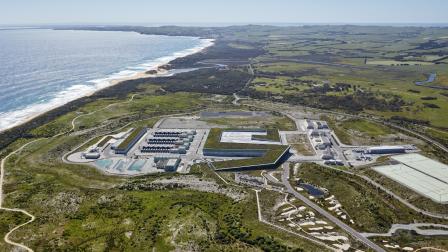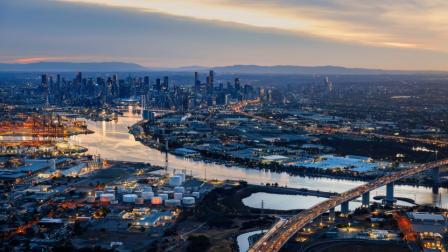Greater Melbourne Urban Water and System Strategy: Water for Life (known as ‘Water for Life’) is a shared plan, developed by Greater Western Water, Melbourne Water, South East Water and Yarra Valley Water.
The strategy outlines how we plan to shore up Melbourne’s water supplies for the next 50 years. This includes how we aim to balance Melbourne’s water needs by increasing efficiencies, diversifying water sources and using new water supplies.
Water for Life builds on the work we’re already delivering to provide Greater Melbourne with a secure and sustainable water supply for the next 50 years.
Our water challenges
We face considerable water challenges over the next 50 years
Melbourne is consistently ranked as one of the world’s most liveable cities and water makes a significant contribution to the prosperity of people and places. However projected population growth, together with uncertain climate conditions, present challenges for Melbourne’s water future.
We also need to provide enough water for the environment to maintain waterway health and to preserve and protect Traditional Owner values.
We need to act now
While we have the benefit of time, we need to act now to be ready for the uncertainty that lies ahead.
Our findings show that we need to add more manufactured water such as desalination, and fit for purpose recycled water and stormwater to our existing system within the next 10 years, as well as several other system augmentations over the next 50 years. We also need to make sure we are using the water we have more efficiently including finding ways to use less water in our homes, businesses, communities and distribution networks.
By planning now we ensure we can deliver on these initiatives and future proof Greater Melbourne’s water supply.
Water for a growing Melbourne
In Melbourne, a safe and reliable water supply system is essential to our way of life. Every day, we supply around 1,250 million litres of drinking water to over 5 million Melburnians.
By 2030 nearly 6 million Melburnians will need water every day. And come the middle of the century, Melbourne’s population is expected to double. That’s why we need to plan now to ensure we continue to service the city’s growing water needs.
The impacts of climate change bring hotter and drier weather, more severe weather events, less water flowing into our rivers and of course the possibility of another drought.
Together with higher water demand, by 2070 we may need to double our water supplies – meaning we’d need to add an average of 12 billion litres of additional supply each year.
While our storages are in a strong position now, an overall trend of warmer and drier conditions is expected over the next 50 years.
The amount of water we have available can change quickly. Maintaining high storage levels helps ensure we can adapt while having time to plan and make system improvements to protect this precious resource for our city.
Download it now
Want to know more? Download the Water for Life Strategy now:
Frequently Asked Questions
- What is Water for Life and who produced it?
-
Water for Life is a joint strategy for the future, which plans to ensure a safe and secure water supply for Greater Melbourne over the next 50 years, including specific actions for the next 5 years.
It was developed collaboratively by Greater Western Water, Melbourne Water, South East Water and Yarra Valley Water, in partnership with neighbouring regional water corporations.
- What area does the strategy cover?
-
The strategy covers the entire service regions of Greater Western Water, Melbourne Water, South East Water and Yarra Valley Water. Throughout the strategy we refer to this area collectively as Greater Melbourne.
- How was the strategy developed?
-
Beyond industry collaboration, the strategy is also a shared plan with Traditional Owners and the community. As part of the development process, both groups developed a set of criteria which was used to assess and short-list future options.
- What stage is the strategy in now?
-
We’re in a 5-year implementation phase and each of Melbourne's water corporations have already begun delivering on projects which support outcomes of the strategy. This work is being coordinated through the Managing Directors Accord, set up to tackle the region’s biggest challenges.
Progress against the strategy is reported at the end of each year as part of the Annual Water Outlook.
- Why is the strategy important?
-
Across Greater Melbourne, we’re facing some big water challenges. Our population is growing and we’re using more water, our climate is drying and there’s less water in our rivers. Add to that an expanding grid of customers and a thriving economy, and we’re seeing increasing pressure put on our most valuable resource – water.
Looking forward, under some climate and demand scenarios, we’ll start reaching an imbalance in supply and demand in the next 10 years. That means we’ll have to take action beyond our current solutions to ensure Greater Melbourne has enough water into the future.
- Why do we need to act now?
-
Our current water storage levels are secure, but from history we know droughts can start suddenly and last for an extended period. Even if we don’t experience a drought over the coming decade, the amount of water we receive from our catchments may not be enough to meet our needs.
Responding to this potential water supply shortfall will require investment in significant infrastructure. This infrastructure takes a long time to plan and build. By planning and preparing now, and ensuring infrastructure is ready to be built when needed, we can ensure that we make the right investment at the right time.
- What options will Water for Life deliver?
-
There’s no single solution to the complex challenges we face. Water for Life will deliver a range of options in 3 categories:
- Enhancing and expanding our existing system (including new manufactured water sources, like desalination).
- Water efficiency (including finding ways to use less water in our homes, businesses, communities and distribution networks, like through behaviour change programs, digital meters and water efficient household appliances).
- Integrated water management (including using recycled water and stormwater for non-drinking uses, to reduce demand on our drinking water supplies).
You may also like...
Our water supply challenges
Population growth and climate change are creating a new normal for our water supply. Let's talk about the key issues.

How we’re taking action
Melbourne’s water corporations are working hard with government and a range of other partners to secure our water supply.

Water Outlook
A summary of the state of Melbourne’s water availability for the year ahead, and our actions to secure a resilient, reliable water supply.




